Wyoming, the Equality State, is renowned for its stunning landscapes, rugged mountains, and vast open spaces. Planning a trip here means considering its diverse and often dramatic climate. What constitutes the Best Climate In Wyoming really depends on your travel goals, whether you’re chasing summer warmth, seeking winter snow adventures, or prefer mild shoulder seasons. Due to its high elevation and continental location, Wyoming’s climate is characterized by significant seasonal variations and regional differences, offering a unique set of weather patterns for every visitor.
Wyoming’s Climate: An Overview for Travelers
Because of its average elevation, which is among the highest in the United States, Wyoming generally experiences a relatively cool climate. The state ranks 41st in the U.S. for its annual average temperature, which sits around 45.6°F. Above the 6,000-foot mark, you’ll find that temperatures seldom climb over 100°F, contributing to more moderate summer conditions in mountainous areas.
Warmer pockets can be found in the lower parts of the Bighorn Basin, the central and northeastern lowlands, and along the eastern border. These regions tend to have higher average temperatures, particularly during the summer months. The state’s climate diversity is a key factor when trying to pinpoint the Best Climate In Wyoming for specific activities or times of year.
Annual average temperature distribution across Wyoming.
Wyoming Summers: Warm Days, Cool Nights
Summertime in Wyoming, typically July, brings the warmest temperatures. Mean maximum temperatures across most of the state away from the mountains range between 85°F and 95°F. For example, Basin in the Bighorn Basin has an average maximum temperature of 92°F in July. However, with every 1,000-foot increase in elevation, average temperatures drop by about 5.5°F.
This means that mountain areas at elevations around 9,000 feet might only see average maximums near 70°F in July. A defining characteristic of Wyoming summers is the coolness of the nights, even after a hot day. Mean minimum temperatures in July range from 50°F to 60°F in lower elevations, while mountains and high valleys can drop into the 30s or 40s°F, sometimes even falling below freezing. This cool overnight respite is a welcome feature for many visitors.
Wyoming Winters: Dramatic Swings and Cold Snaps
Wyoming winters are known for their frequent and rapid shifts between mild and cold periods. The state typically experiences several cold waves each winter, often moving southwards east of the Continental Divide. While not all cold waves bring heavy snow, blowing snow can significantly reduce visibility, creating challenging travel conditions.
January is generally the coldest month. Minimum temperatures mostly range from 5°F to 10°F, but western valleys can see mean values drop to around -5°F. Record lows highlight the extreme cold possible, with the state’s lowest potentially being -63°F at Moran 5WNW. Winter extreme cold days have shown a decreasing trend over recent decades, while extreme warm days in winter have slightly increased, indicating some shifts in seasonal patterns relevant to the Best Climate In Wyoming.
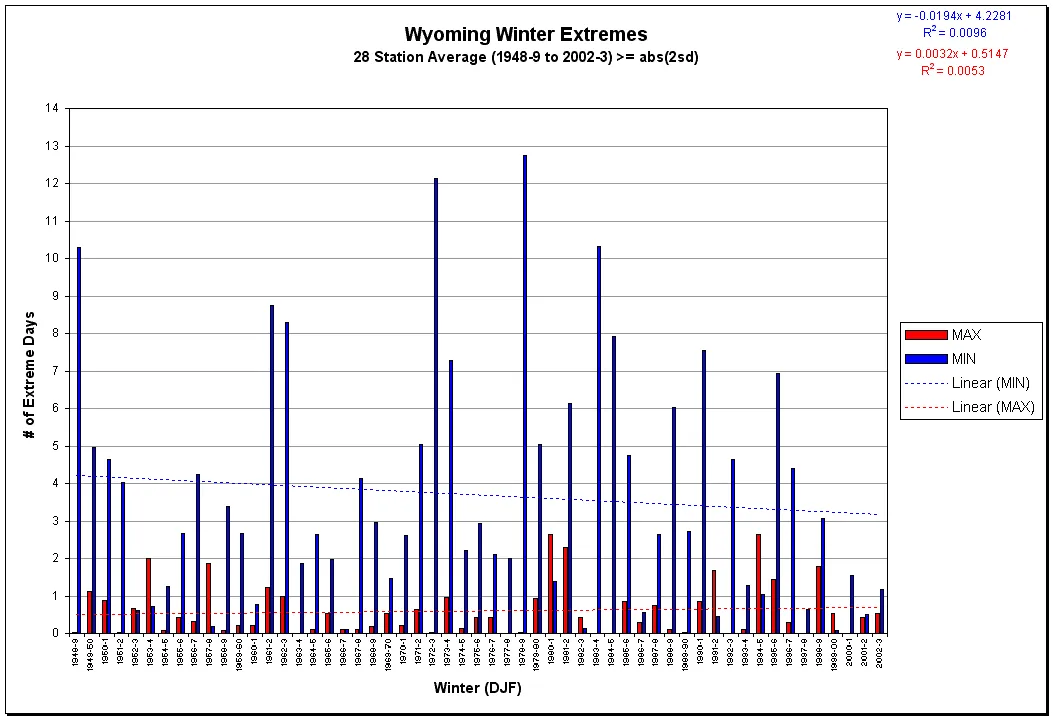 Figure showing average number of extreme cold and warm days in Wyoming winters over 55 seasons
Figure showing average number of extreme cold and warm days in Wyoming winters over 55 seasons
During warmer winter spells, nighttime temperatures can stay above freezing. Chinook winds, warm downslope winds, are common along the eastern slopes and can cause rapid temperature increases. However, numerous valleys provide perfect conditions for cold air pooling at night, leading to significantly lower temperatures than nearby mountainsides. Big Piney in the Green River Valley is a prime example of such a location, often experiencing very low minimum temperatures.
Understanding Wyoming’s Temperature Extremes
Wyoming’s climate is marked by a wide range of temperature extremes. The state has experienced a temperature span exceeding 180°F between its all-time highest and lowest recorded readings. The record high is 116°F, observed on July 12, 1900, at Bitter Creek in Sweetwater County. The record low is likely -63°F at Moran 5WNW, although a historical -66°F at Riverside R.S. in Yellowstone Park is under review.
Understanding these extremes is crucial for planning travel. Figure 3.2 shows the average number of days each year with temperatures above 90°F. Such hot days are rare at higher elevations but can occur frequently (more than 40 days per year) in the Bighorn Basin and eastern plains. Figure 3.3 illustrates days with freezing temperatures (32°F or colder). These exceed 228 days in the mountains but are about half that number in parts of the eastern plains and central river basins. This geographical variation heavily influences the Best Climate In Wyoming depending on your chosen destination within the state.
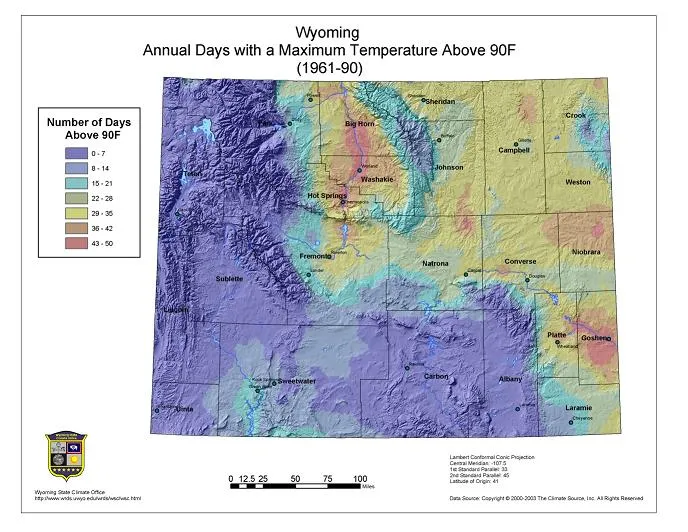 Map showing average number of days per year with temperatures above 90°F in Wyoming
Map showing average number of days per year with temperatures above 90°F in Wyoming
Discover the Best Overnight Summer Camps in Texas
Your Ultimate Guide to Oktoberfest Los Angeles 2024
Discover the Best Things to See in Sarasota
 Map showing average number of days per year with temperatures at or below 32°F in Wyoming
Map showing average number of days per year with temperatures at or below 32°F in Wyoming
Heat Index and Apparent Temperature: What It Feels Like
While less humid than many other regions, heat combined with humidity can still be a factor in Wyoming, particularly in lower elevations. The Heat Stress Index helps assess how hot it actually feels to the human body by calculating an “apparent temperature.” This is distinct from the NOAA Heat Index, which isn’t defined for temperatures below 80°F and humidity below 40 percent – conditions common in parts of Wyoming.
Instead, the Steadman (1984) apparent temperature calculation is used. Threshold values indicate when heat stress conditions are more likely. For Cheyenne, the 85th percentile (exceeded about a dozen days in July/August) apparent maximum temperature is 83.2°F, while the actual temperature threshold is 86.6°F. Notably, in some cases, due to very low relative humidity, the apparent temperature can actually feel lower than the actual air temperature. Understanding this can help identify periods that might be uncomfortably hot, even if the humidity isn’t high.
Growing Season and Freeze Dates: Planning Your Visit
Wyoming’s climate, particularly the timing of freezes, significantly impacts its natural and agricultural cycles. Early fall freezes and late spring freezes are typical, resulting in relatively long winters and shorter growing seasons. For the main agricultural areas, the average freeze-free period is around 125 days. For hardier plants that can tolerate temperatures around 28°F, the season is slightly longer, approximately 145 days, particularly east of the Continental Divide.
In the mountains and high valleys, freezing temperatures can occur any month of the year. For sensitive plants, areas like the upper Green River Valley, Star Valley, and Jackson Hole have extremely short or practically non-existent growing seasons. Sandy Creek near Farson averages only 42 freeze-free days. This impacts everything from agriculture to the best times for camping and hiking at higher elevations, as you must be prepared for potential freezes even in summer.
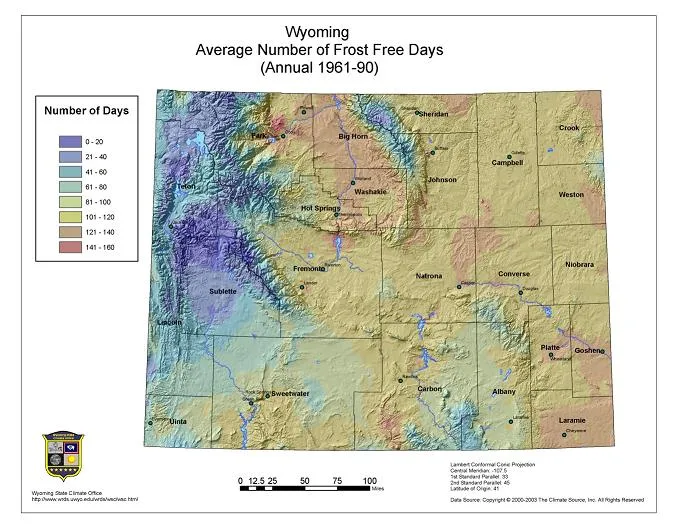 Map showing mean number of annual frost-free days in Wyoming
Map showing mean number of annual frost-free days in Wyoming
Understanding the earliest expected freezing dates (Figure 3.6) and latest expected freezing dates (Figure 3.7) is vital for agricultural planning but also for travelers planning outdoor activities in the shoulder seasons. Julian Days are used to mark the progression through the year, indicating when frost is likely. For instance, an early Julian Day number for the latest freeze means spring arrives earlier, while a late Julian Day number for the earliest freeze means fall warmth lingers longer.
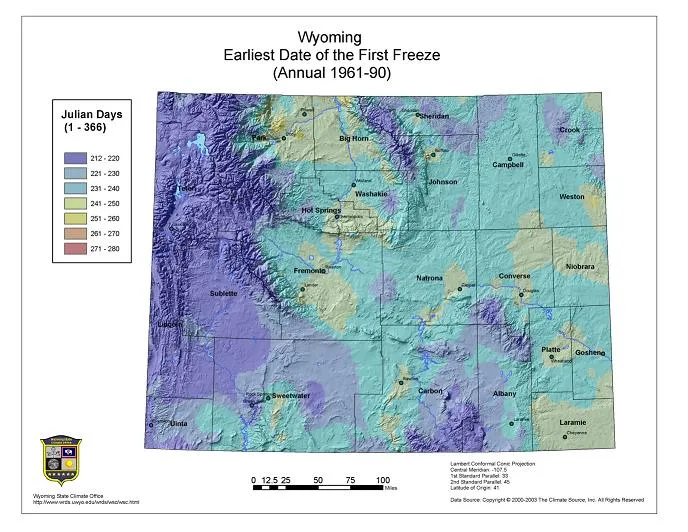 Map showing earliest expected freezing date in Julian Days in Wyoming
Map showing earliest expected freezing date in Julian Days in Wyoming
 Map showing latest expected freezing date in Julian Days in Wyoming
Map showing latest expected freezing date in Julian Days in Wyoming
Regional Temperature Variations: Finding Your Sweet Spot
Figure 3.1, showing the annual average temperature, clearly illustrates how climate varies across Wyoming. Higher terrain consistently results in cooler average temperatures throughout the year. Lower elevations, such as those in the Bighorn Basin, Lower North Platte, and Powder-Tongue river basins, tend to be considerably hotter, requiring more cooling (Figure 3.13 illustrates Cooling Degree Days, which correlate with air conditioning needs).
The relationship between temperature and altitude is strong (Figure 3.32). Higher elevations have fewer days above 89°F. Wind direction also plays a role (Figure 3.33). Winds from the south generally bring warmer air, while winds from the north bring cooler air. However, downslope winds, particularly Chinooks on the leeward side of mountain ranges like the Big Horn and Wind River, can cause rapid warming regardless of originating direction. These regional variations mean the Best Climate In Wyoming can be found in different areas depending on the season.
 Map showing Wyoming maximum annual heating degree days
Map showing Wyoming maximum annual heating degree days
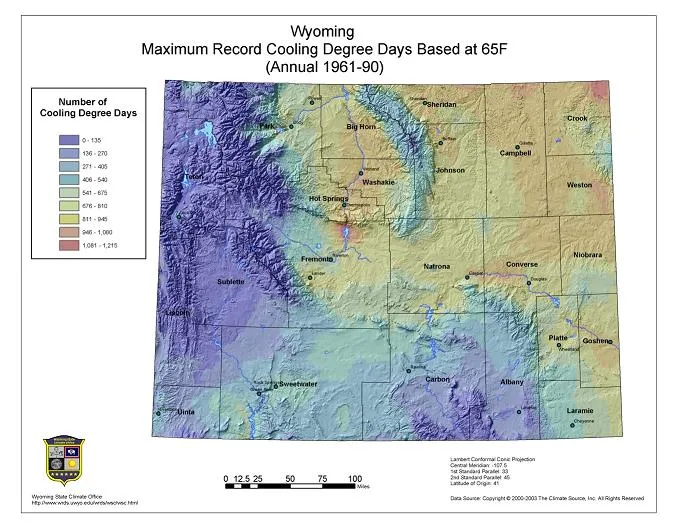 Map showing Wyoming maximum annual cooling degree days
Map showing Wyoming maximum annual cooling degree days
Wyoming’s climate can also feature rapid hourly and daily temperature changes. While most hourly changes are minor, significant swings exceeding 12°F or even 20°F within an hour can occur, often linked to front passages, wind shifts, or thunderstorms. Daily temperature changes of +/- 10°F or more are relatively common, particularly in winter months (Table 3.F). Extreme 24-hour swings have been recorded, demonstrating the dynamic nature of the state’s weather. This volatility requires travelers to pack layers and be prepared for sudden shifts, regardless of the season.
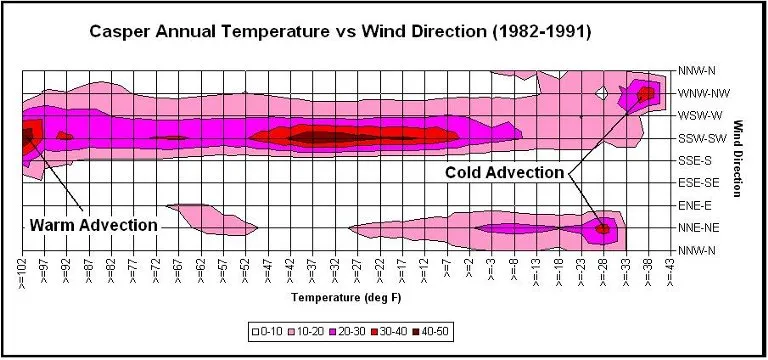 Figure showing frequency of temperature as a function of wind direction for Casper
Figure showing frequency of temperature as a function of wind direction for Casper
Choosing the Best Time to Visit Wyoming
Finding the Best Climate In Wyoming depends entirely on what you want to do and experience.
- Summer (June-August): Generally offers the warmest temperatures, especially in lower elevations, ideal for classic summer activities. Nights remain cool statewide, offering relief. Be prepared for potential heatwaves in valleys and possible afternoon thunderstorms or cool snaps in the mountains. This is peak season for national parks and outdoor recreation.
- Fall (September-November): Can bring beautiful foliage and pleasant, crisp days. However, be mindful of early freezes, particularly in September and October. Weather becomes increasingly volatile as winter approaches. Great for hiking in lower elevations and experiencing seasonal changes.
- Winter (December-February): Perfect for snow sports enthusiasts. Expect cold temperatures, but also periods of milder weather thanks to Chinooks. Be prepared for significant cold snaps and potential road closures due to snow and wind. This is the quietest time to visit, offering solitude in certain areas.
- Spring (March-May): A highly variable season. Can swing from cold and snowy to warm and sunny rapidly. Snowmelt can impact trail conditions. Wildlife is often active as temperatures rise. Offers fewer crowds than summer, but unpredictable weather requires flexibility.
For mild weather without extremes, late spring and early fall can be ideal, but they are also the most unpredictable. If warmth is your priority, aim for July or August in the lower elevations. If you prefer cooler temperatures, head to the mountains in summer.
Frequently Asked Questions About Wyoming’s Climate
- What is the warmest month in Wyoming?
Typically, July and August are the warmest months across Wyoming. - What is the coldest month in Wyoming?
January is generally the coldest month. - Is Wyoming always windy?
Wyoming is known for being windy, especially the eastern plains and areas along the front ranges where downslope winds occur. While not always windy, it’s a frequent factor in the climate. - When is the best time to visit for mild weather?
Late May/early June or September can offer mild temperatures, but these shoulder seasons are also prone to rapid weather changes and late/early freezes, particularly at higher elevations.
Experiencing Wyoming’s Diverse Climate
Wyoming’s climate is a fundamental part of its identity and natural beauty. From the scorching potential of a Bighorn Basin August afternoon to the bitter cold of a January morning in a high valley, the state offers a full spectrum of conditions. Understanding these patterns is key to planning your adventure and truly experiencing the essence of this vast and wild place. Finding the Best Climate In Wyoming isn’t about avoiding weather altogether, but about aligning the weather with your desired experiences, whether it’s hiking under crisp autumn skies, feeling the warmth of the summer sun, or embracing the dramatic beauty of a winter landscape.
